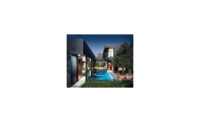Raleigh, North Carolina
A steep escarpment and a wooded site shaped Frank Harmon’s design for the Strickland-Ferris Residence in Raleigh, North Carolina. Built for Lynda Strickland, a North Carolina native who returned home after a couple of decades of living in Washington, D.C., and other places, the 1,800-square-foot house perches above the ground, supported by nine wood trusses sitting on concrete columns. “We knew we had to raise the house off the ground and let the water flow under it,” says Harmon. The strategy not only preserved the site’s hydrological patterns but allowed the architect to build without cutting down any major trees in the 150-year-old beech-and-oak forest.

Additional Content:
Jump to credits & specifications
To collect rainwater (for use in irrigating the forest floor), Harmon designed a butterfly roof with a gutter running along its crease. “It looks like a Wright flyer,” says the architect, referring to the first plane launched by the Wright brothers at Kitty Hawk, about 200 miles away. The flight imagery is particularly strong as you drive up to the house and see just the roof floating above a band of windows wrapping around the top of the building. Below this transparent “cornice,” though, the house presents a mostly opaque face to the street, with cement board protecting the interior from the southern sun and views from neighboring houses. Deep eaves also shade the upper glass band from direct rays of the sun.
From the street, you enter the house at its upper level via an ipé-wood bridge. As you step inside, you’re greeted with an expansive view of the woods and, in the distance, Crabtree Creek. “I wanted to feel as if I were living in the trees,” explains Strickland. A glass-and-steel wall running the length of the building on its north facade and reaching as high as 27 feet creates an ethereal boundary between inside and out, between modern living and the great outdoors. Polished cherry-wood floors, as well as laminated-wood beams and columns, bring a natural warmth to the large, open living-dining space. Harmon used salvaged steel for an elegant stair that glides along the glass wall, and Strickland found sheets of scrap metal to clad the kitchen’s backsplash and the low partitions enclosing the master bathroom upstairs. The juxtaposition of luxurious materials like polished cherry and rough ones like plywood and scrap steel reminds Harmon of Japanese temples where gold leaf sometimes coats rough-wood columns.
Strickland had taken a class on architectural appreciation taught by Harmon years before and was thoroughly engaged in the design of her house. “This was a real collaboration between client and architect,” states Harmon. Strickland told Harmon from the start that she wanted a house with no ornamentation. Instead, exposed beams, sloping plywood ceiling, and the client’s collection of Modern furniture provide the necessary visual appeal whenever people aren’t staring out the windows and soaking up the view. She also insisted on keeping the manufacturer’s markings on the wood beams, injecting a quirky reminder of provenance to structural members.
CreditsArchitect Frank Harmon, FAIA Partner in Charge Sarah Glee Queen Project Manager
Interior designer:
Engineer(s):
General contractor:
Photographer(s) Jeffrey Jacobs
CAD system, project management, or other software used: PowerCADD |
SpecificationsStructural system: Wood: EIFS, ACM, or other: Roofing Windows Aluminum: Doors Sliding doors: Interior finishes Metals stairs and rain chain by Liquid Forge |


